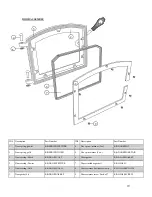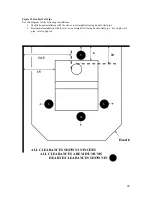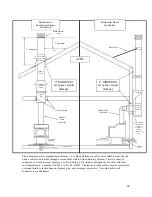
14
Section
4
– Wood burning operation instructions
IMPORTANT:
Your new KUMA wood stove is shipped with a baffle packing to eliminate damage in shipping. Once the
stove is set in place and ready to use you will need to remove the baffle restraints. To remove the baffle
restraints, cut the ties in front of the nylon buckle and pull forward on the bottom cable until it pulls out.
Remove the two cardboard pieces from on top of the baffle and discard. Be careful not to dislodge or
damage the ceramic wool blanket on top of the bricks. Your stove is now ready for operation.
CAUTION:
When building the first couple of fires, be careful to build the fire small and increase the heat slowly over a
4-5 hour period. The paint on the stove cures with heat and needs to be done slowly. As the paint cures, it
A word about draft.
The principle of draft is that warm air rises. Your chimney provides draft which sucks the smoke up the
chimney. The stove does not “push” out the smoke. Your Wood Classic stove has been designed and
approved for use under normal conditions. Unacceptable smoking usually indicates poor draft in your
chimney system, not a problem with your stove.
Reccomendations on building and maintaining a fire.
Start by opening the air control on the stove to fully open. Fully open, depending on the model, will be
pulled all the way out to the left, pulled all the way forward, or in the case of the largest stove, the two
vents near the bottom will be pushed towards the center.
NEVER USE FLAMIBLE LIQUIDS TO START OR FRESHEN UP A FIRE.
Using a good firestarter can make lighting a fire much easier. There are several different types of firestarter
available in “chips” “nuggets” and gels. Newspaper also makes a good fire starter if it is torn into strips.
When building a fire, use plenty of fire starter on the bottom and use small kindling directly on top of that.
Use progressivly larger pieces as you stack wood all the way to the top of the firebox. When starting a fire
you should never use unsplit pieces of wood unless they are small, such as twigs and branches.
Once the wood is stacked in the firebox, you may light the fire starter and leave the door slightly cracked
open for a few minutes to aid in the start up of your stove. Once the fire is well lit, shut the door, but leave
the air control in the open position for about 20-30 minutes. After burning for about a half an hour in the
open position, you can start to regulate the heat output and burn rate by shutting the air control down.
Remember to let your stove burn open for 20-30 minutes each time you reload it with wood. Shutting the
air control prematurely can cause excessive creosote in the chimney. Use the following as a general
guideline for desired burn rates.
Low burn
Draft handle pushed all the way in
Med-Low burn
Draft handle pulled out approximately 1/8” – ¼”
Medium burn
Draft handle pulled out approximately ¼” – ½”
Med-High burn
Draft handle pulled out approximately ½” – 1”
High burn
Draft handle pulled out all the way
Additional instructions and information.
1.
Build your fires directly on the firebrick. Using a grate will allow too much air to the coal bed and
will result in incomplete combustion of the wood. Using a grate can also leave charred pieces of
wood after the fire has gone out.
2.
Use only the best grade of dry wood available. Wood should be seasoned for 1 full year prior to
being used. Split wood will season much faster and better that wood left in the rounds. Burning
green or wet wood greatly increases the chance of creosote build up and produces significantly
less heat.
The number 1 cause for creosote build up is moisture in the wood.
Store your wood
in a dry location.
Any wood stored near the stove needs to maintain proper clearance from the
stove.















































